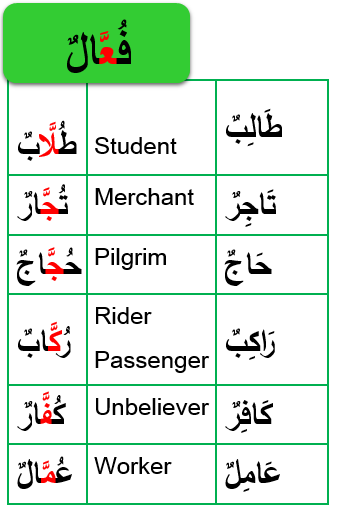Arabic Broken plurals Patterns الجمع التكسير
Nouns that pluralize by internal vowel change – the so-called ʻbrokenʼ
فُعَّالٌ طُلَّابٌ Student طَالِبٌ تُجَّارٌ Merchant تَاجرٌ حُجَّاجٌ Pilgrim حَاجٌ رُكَّابٌ Rider Passenger رَاكِبٌ كُفَّارٌ Unbeliever كَافِرٌ عُمَّالٌ Worker عَاملٌ
فِعَالٌ رِجالُ Man رَجُلٌ كِبَارٌ Big/great كَبِيْرٌ صِغَارٌ small صَغِيرٌ قِصَارٌ short قَصِيرٌ طِوَالٌ tall طَوِيْلٌ ضِعَافٌ weak ضَعيفٌ جِبَالٌ mountain جَبَلٌ كِلابٌ Dog كَلْبٌ بِحَارٌ Sea بَحْرٌ بِلادٌ country بَلَدٌ صِعَابٌ difficult صَعَب
أفعَالٌ أَ وْلاَدٌ Child وَلَدٌ أَ بْناء Son إبْنٌ أَ عْمَامٌ Paternal uncle عَمُّ أَ زْوَاجٌ Spouse Husband زُجن آ بَاءٌ Father أبٌ أَ قلامٌ Pen قَلَمُ أ بوابٌ Door بَابٌ أ نْهَارٌ River نَهْرٌ أَ يَّامٌ day يَوْمٌ أَ لوَانٌ Color لَوْنٌ أ مطارٌ Rain مَطَرٌ أَ وقاتٌ Time وَقْتٌ أَ صْحَابٌ Companion صَاحِبٌ أَ سْمَاءٌ Name اِسْمُّ أ طفالٌ Infant طِفْلٌ أ مثالٌ Example مِثَالٌ أ نوارٌ Light نوْرٌ
فُعُوْلٌ شُيُوْخٌ Sheikh شَيْخٌ ضُيوُفٌ Guest ضَيِفٌ حُقُوْلٌ Field حَقْلٌ قُلُوْبٌ Heart قَلْبٌ نُجُوْمٌ Star نَجْمٌ بُيُوْتٌ House بَيْتٌ دُرُوْسٌ Lesson دَرْسٌ قُرُوْش Monetray coin قِرْشٌ جُيُوْبٌ Pocket جَيْبٌ حُرُوْفٌ letters حَرْفٌ مُلُوْكٌ King مَللِكٌ عُلُوْمٌ Knowledge عِلْمٌ قُصُوْرٌ Palace قصْرٌ سُيُوْفٌ Sword سَيْفٌ
فِعْلَةٌ اِخْوَةٌ Brother أَجٌ فِتْيَةٌ Youth فَتًى
فُعُلٌ كُتُبٌ Book كِتَابٌ جُدُدٌ New جَدِيْدٌ سُرُرٌ Bed سَرِيْرُ رُسُلٌ Messenger رَسُوْلٌ مُدُن City مَدِينْةُ سُفُنٌ ship سَفِيْنةٌ طُرُقٌ Road/way طِرِيقٌ حُمُرٌ Donkey حِمار
فُعَلاُ زُمَلاَءُ Colleague زَمِيْلُ فُقَرَاءُ Poor فَقِيْرٌ عُلَمَاءُ Learned عَاِلمٌ سُفَرَاءُ Ambassador سَفيِرٌ وُزَرَاءُ Minister وَزِيْرٌ أُمَرَاءٌ Leader أَمِيْرٌ حُفَدَاءٌ حَفِيدٌ
أفعِلاَءُ أَغْنِيَاءُ Rich غَنِيٌ أَصْدِقَاءُ Friend صَدِيْقٌ أقْويَاءُ Strong قويٌ أذكيَاءُ Intelligent ذَكِيٌ أنْبيَاءُ Prophet نَبِيٌ أطِبَّاءُ Doctor طَبِيْبٌ أقْرِباءُ Near قَرِيبٌ
مَفَاعِلُ مَمنُوعٌ من الصَّرفِ مَسَاجِدُ Mosque مَسْجِدٌ مَلابِسُ Clothes مَلْبَسٌ مَسَاطِرُ rulers مِسْطَرَةٌ مَدَارِسٌ School مَدْرَسَةٌ مَجالِسُ Assembly مَجْلِسٌ مَنَازِلٌ House مَنْزِلٌ مَصَانِعُ Factory مَصْنَعٌ مَكَاتِبُ Desk مَكْتَبٌ دَفَاتِرُ Notebook دَفْتَرٌ دَقائِقُ Minute دَقِيْقَةٌ فَنَادِقُ Hotel فَنْدُقٌ كَوَاكِبُ Planet كَوْكَبٌ جَوَاهِرُ Essence Substance جَوْهَرَةٌ تَجَارِبُ Experment تَجْرَبَةٌ
مَفَاعِيلُ مَفَاتِيْحٌ key مِفْتَاحٌ مَنَادِيْلُ Kerchief مَنْدِيْلٌ فَنَاجِيْنُ Cup فِنْجَانٌ صَنَادِيْقُ Box صَنْدُوْقٌ كَرَاسِيُّ Chair كُرْسِيٌّ
أَفْعِلَةٌ أَسْئِلَةٌ Questiom سُؤَالٌ أجْوِبَةٌ Answer جَوابٌ أمْثِلَةٌ Example مِثَالٌ أطْعِبمَةٌ Food طَعَامٌ أعْمِدَةٌ Pillar عَمُوْدٌ
أَفْعُلْ أشْهُرٌ Month شَهْرٌ أرْجْلٌ Leg foot رِجْلٌ أَنْفُسٌ Soul Self نَفْسٌ أذرُعٌ Arm أذِرَاعٌ
فُعْلاَنٌ قُمْصَانٌ shirt ٌقََمِيْص بُلْدَانٌ Country بَلَدٌ
